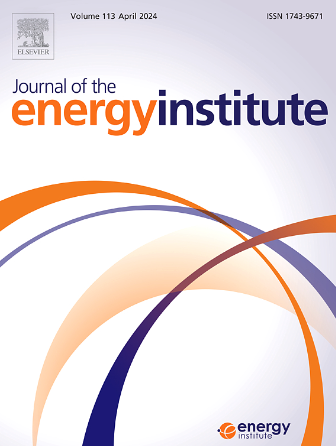Hydrogen production enhancement via methanol steam reforming with copper-zinc catalysts
IF 5.6
2区 工程技术
Q2 ENERGY & FUELS
引用次数: 0
Abstract
Methanol steam reforming (SRM) integrated with fuel cells presents a promising solution for sustainable hydrogen (H2) generation, enabling on-site production from liquid methanol. In this study, Cu-Zn catalysts were synthesized using homogeneous precipitation (HP) and co-precipitation (CP) methods, with samarium (Sm), gadolinium (Gd), and cerium (Ce) employed as rare-earth promoters. Catalysts prepared by the HP method with 1.5 M urea showed the highest performance, as confirmed by FE-SEM, BET, and XRD analyses. The addition of Sm, Gd, and Ce enhanced Cu dispersion, lowered the reduction temperature (T95), reduced CO formation, and increased hydrogen yield (FH2). The most active catalysts, CuO/ZnO/Sm2O3/CeO2 and CuO/ZnO/Gd2O3/CeO2, achieved over 90 % methanol conversion at 240 °C. Catalysts were loaded into U-shaped stainless steel packed-bed reactors (PBRs), and the SRM process was conducted under controlled temperature and flow conditions. The hydrogen-rich gas (HRG) produced was analyzed using gas chromatography (GC-TCD). A complete methanol reforming fuel cell system was developed by coupling the SRM reactor with a high-temperature proton-exchange membrane fuel cell (HT-PEMFC). The system produced a stable electrical output of 20 W, with peak output reaching 30 W, confirming the feasibility of in situ hydrogen production for fuel cell applications. These results highlight the effectiveness of rare-earth-modified Cu-Zn catalysts for integrated SRM-fuel cell systems in clean energy technologies.

铜锌催化剂催化甲醇蒸汽重整提高制氢效率
甲醇蒸汽重整(SRM)与燃料电池的集成为可持续制氢(H2)提供了一个有前景的解决方案,使液态甲醇能够在现场生产。本研究以钐(Sm)、钆(Gd)和铈(Ce)为稀土促进剂,采用均相沉淀法(HP)和共沉淀法(CP)合成Cu-Zn催化剂。通过FE-SEM、BET和XRD分析证实,以1.5 M尿素为原料的HP法制备的催化剂性能最好。Sm、Gd和Ce的加入增强了Cu的分散,降低了还原温度(T95),减少了CO的生成,提高了氢的产率(FH2)。在240℃条件下,CuO/ZnO/Sm2O3/CeO2和CuO/ZnO/Gd2O3/CeO2催化剂的甲醇转化率均达到90%以上。将催化剂装入u型不锈钢填料床反应器(PBRs)中,在控制温度和流动条件下进行SRM工艺。采用气相色谱法(GC-TCD)对生成的富氢气体(HRG)进行分析。将SRM反应器与高温质子交换膜燃料电池(HT-PEMFC)耦合,建立了完整的甲醇重整燃料电池系统。该系统产生了20 W的稳定电力输出,峰值输出达到30 W,证实了原位制氢燃料电池应用的可行性。这些结果突出了稀土改性Cu-Zn催化剂在清洁能源技术中集成srm -燃料电池系统的有效性。
本文章由计算机程序翻译,如有差异,请以英文原文为准。
求助全文
约1分钟内获得全文
求助全文
来源期刊

Journal of The Energy Institute
工程技术-能源与燃料
CiteScore
10.60
自引率
5.30%
发文量
166
审稿时长
16 days
期刊介绍:
The Journal of the Energy Institute provides peer reviewed coverage of original high quality research on energy, engineering and technology.The coverage is broad and the main areas of interest include:
Combustion engineering and associated technologies; process heating; power generation; engines and propulsion; emissions and environmental pollution control; clean coal technologies; carbon abatement technologies
Emissions and environmental pollution control; safety and hazards;
Clean coal technologies; carbon abatement technologies, including carbon capture and storage, CCS;
Petroleum engineering and fuel quality, including storage and transport
Alternative energy sources; biomass utilisation and biomass conversion technologies; energy from waste, incineration and recycling
Energy conversion, energy recovery and energy efficiency; space heating, fuel cells, heat pumps and cooling systems
Energy storage
The journal''s coverage reflects changes in energy technology that result from the transition to more efficient energy production and end use together with reduced carbon emission.
 求助内容:
求助内容: 应助结果提醒方式:
应助结果提醒方式:


